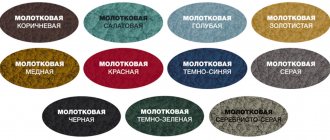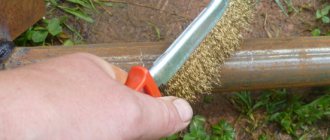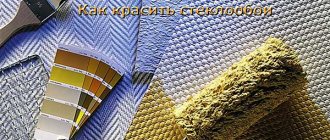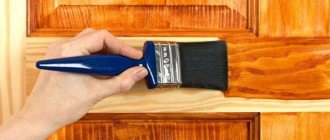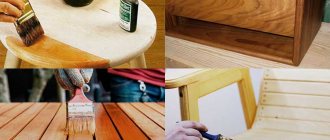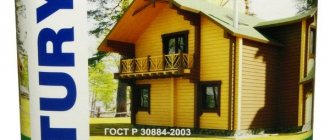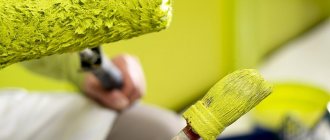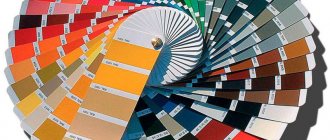Among the many varieties of paints, there is also oil paint for walls. Thanks to it, the surface will be beautiful and protected from external factors. Unfortunately, with the growth of technological progress and the creation of new types of paints, they began to forget it. Not only is it called outdated, but it is also criticized for being quite toxic. Now water-based paints, enamel, acrylic or latex, are considered more popular.
In this article we will take a closer look at the features of oil paint, its characteristics and the principle of application to the surface.
Oil formulations
Oil compositions are used for painting internal and external surfaces of brick, plaster, wood, and metal.
The selection of oil colors is carried out basically in almost the same way as adhesive ones. Coders should be prepared from thickly ground paints, first of the color that predominates in the color scheme, then paints of other colors are gradually added to it. Thickly grated oil paints are pre-dissolved with drying oil to a working consistency. Coders are made from these workers.
Oil compositions should be in the form of thick sour cream. The paint should be applied to the surfaces to be painted in an even layer, shaded well without rough streaks or streaks. A liquid composition will flow, but a very thick composition will lay down in a thick layer and wrinkle when drying.
Thus, when selecting various paint compositions, it is necessary to achieve the desired degree of spillage or their mobility. With good mobility, traces of paint spread after some time and form a smooth coating without any streaks.
Viscosity is determined using various instruments. The simplest and most accessible is the VZ-4 viscometer (Fig. 1), which is a duralumin or plastic vessel that turns into a full cone. The upper cylindrical part has a groove for draining excess paint. The conical part ends with a stainless steel nozzle. The nozzle has a height of 4 mm, and there is a hole with a diameter of 4 mm inside it. The volume of the viscometer vessel is 100 cm3.
Before determining the viscosity, the tested paint, drying oil or other composition is heated to a temperature of 18-20° with thorough mixing of the entire mass. The viscometer should also be heated to the same temperature. Having secured the viscometer in a tripod and placed a dish under it, close the nozzle hole with your finger, pour a full vessel (100 cm3) of the composition into the viscometer, then remove your finger from the nozzle, while simultaneously turning on the stopwatch.
After the continuous flow ceases, the stopwatch is stopped. The flow time in seconds serves as an indicator of the relative viscosity.
For example, drying oil of normal viscosity flows out completely after 23-26 seconds. When prepared oil or other paints turn out to be thick, they are brought to working viscosity by thinning. Enamel paints and varnishes for mechanized painting are brought to viscosity for 35 to 40 seconds in a VZ-4 cup. Perchlorvinyl enamel paints for painting wood, plaster and putty - up to 20-25 seconds.
The mobility or thickness of an oil paint composition can be determined in the same way as an adhesive one, i.e., by running a drop over the glass. The drip length of a drop of oil paint should be 35-50 mm. After applying the color paint to the surface, it should spread well. For example, if the remaining strokes of the color from the brush disappear after about 10 minutes, the color is prepared normally; if this happens before 10 minutes, it is liquid, and after 15 minutes, it is thick. Thickly grated paint is added to liquid coders, and drying oil or thinner is added to thick ones.
1. Oil color on drying oil
| Rubbed oil paint (desired color) | 1000 g |
| Drying oil | From 400 to 600 g |
Drying oil is added in small portions to thickly grated oil paint and everything is thoroughly mixed until a homogeneous composition is obtained. If the paint turns out to be thick, then additional drying oil is poured into it and everything is mixed.
When oil coders are prepared for mechanical spraying, then 50 to 150 g of solvent are added to the above amount of color. It is best to grind the prepared color using a paint grinder.
In addition to drying oil, thickly ground oil paints can be diluted with oil emulsions and emulsion thinners.
2. Color based on oil emulsion
| Thick oil paint (of desired color) | 1000 g |
| Oil emulsion | 850—1000 g |
The oil emulsion is prepared according to one of the recipes indicated earlier. The emulsion must be without the addition of thick paint or pigment; the need for an emulsion depends on the thickness of the paint being diluted.
3. Color with emulsion thinner
| Emulsion thinner | 600 g |
| Rubbed oil paint | 400 g |
Add an emulsion thinner to the thick oil paint and mix thoroughly until the composition is homogeneous. The amount of emulsion thinner may vary depending on the thickness of the paint.
If coloring is done mechanically, then turpentine is added to the paint in an amount of 125-180 g. If the color needs to be prepared from dry pigments, then use 70% emulsion thinner and 30% drying oil. Mix everything together and add pigment there, thoroughly mixing again.
In addition to emulsion thinners, oil-lime compositions are widely used.
4. Oil-lime colors:
| Oil diluted paint of the desired color | 1000 g |
| Lime dough | 730 g |
| Chalk paste | 440 g |
| Turpentine | 110 g |
| Drier | 55 g |
The lime dough is filtered through a fine sieve. Fine chalk is mixed with water to form a thick paste. Then the paint, lime paste, chalk paste, turpentine and drier are placed in a metal bowl, everything is thoroughly mixed and left for a day. After a day, everything is ground on a paint grinder. The result is ready-to-use paint, which dries at a temperature of + 20° no later than after 30 hours. Thickly grated oil paints are diluted to a working consistency with oxol drying oil. This paint paste is widely used in the finishing work trust of the Ministry of Urban and Rural Construction of the BSSR.
This paint is used to paint plaster, frames, doors, pipes, and radiators. The quality of work is good. For every 10 m2 of surfaces, 400 g of white and 2-3 kg of drying oil are saved.
5. Matte color with wax
| Zinc white, grated on drying oil | 1000 g |
| Dry zinc whitewash | 500 g |
| Purified turpentine | 500 g |
| Wax | 100 g |
| Natural drying oil | 25 g |
| Liquid drier | 100 g |
| Pigment dry | As needed |
Prepare the color as follows. The wax is placed in a metal bowl and melted over low heat. The melted wax is removed from the heat, and with thorough mixing, 250 g of turpentine is poured into it, thereby obtaining a wax paste.
Dry zinc white is mixed with the remaining turpentine and drier and everything is ground on a paint grinder. Then the grated whitewash is mixed with wax paste, dry whitewash ground in turpentine is added to it and everything is thoroughly mixed.
The resulting white matte color is, if necessary, highlighted (tinted) with dry pigments, which should be ground with turpentine on a paint grinder. When highlighting the color, dry white should be reduced by the amount of dry pigment taken. The color prepared in this way has a medium matte finish.
6. Matte color without wax
| Ground zinc whitewash | 1000 g |
| Dry zinc white or dry pigments of the desired color | 200 g |
| Turpentine | 200-300 g |
Dry white or pigments are mixed with 100 g of turpentine, ground, mixed with grated white and diluted with the remaining turpentine. The color is used only in dry rooms and under the condition that the surfaces will be painted higher than a person’s height. In this color scheme, dry zinc white can be partially or completely replaced with fine-grained dry chalk.
Semi-matte colors require a decrease in dry pigments or an increase in grated white. Matteness is increased by adding an increased amount of dry pigments or reducing the amount of white grated on drying oil.
7. Semi-matte color
| Ground zinc whitewash | 1000 g |
| Natural drying oil | 100 g |
| Drier | 25 g |
| Purified turpentine | 150 g |
Drying oil is mixed with turpentine and drying agent and everything is mixed with whitewash. When adding pigments for coloring, it is better to first grind them with 50 or 100 g of turpentine, and then add them to the color scheme.
The paint and varnish industry annually adds new names to its products for interior and exterior painting, used for painting any surfaces, including wood. But the love for the usual oil paint on wood turned out to be as good as she herself.
Features of application
The algorithm for using MA15 paint is as follows:
- Surface preparation. Dust, dirt, grease stains, remnants of old coating, scale, and rust are removed from it. Cracks are puttied, irregularities are removed or sealed. The wet surface is dried. It is recommended to pre-apply an alkyd or glypthal primer to increase adhesion (adhesion of the material to the surface). For the first time, wooden products to be painted are impregnated with drying oil or a special primer is applied.
- Preparation of paint and varnish material. Before work, mix the paint and add a solvent if necessary. Pour in little by little - if you exceed the dosage, the quality of the composition deteriorates. If the paint has hardened, heat it in warm water to +20°C or slightly higher.
- Painting works. The paint is applied at a temperature of +5...+35°C, humidity not higher than 80%. The room is ventilated during work and after completion. The tools used are brushes, rollers or a spray gun, depending on the features and surface area.
- Drying. The paint dries in 24 hours if the temperature is about +20°C. Final polymerization occurs within 5 days under the same conditions.
Consumption per layer
Several factors influence material consumption:
- Method of applying paint. The most economical tool is a spray gun, then a roller; the most paint is consumed when applied with a brush. For a pneumatic gun, the most liquid composition is prepared, more solvent is consumed; for a brush - the thickest.
- Surface porosity, ability to absorb coatings. Wood takes more paint than metal. In terms of economy, metal is followed by concrete; then - brick.
- Paint and base color. If the surface being painted is dark, it will show through the paint. Therefore, it is recommended to prime it, choosing a suitable shade. Mostly the primer used is gray for light-colored paints and black for dark paints.
For painting 1 sq. m of surface requires 20-250 g of paintwork.
Optimal layer thickness
A correctly applied layer has a thickness of 25-30 microns. For it to turn out like this, you need to properly prepare the paint: too thick, like liquid, will not ensure the formation of a durable film. The thickness is also influenced by the qualifications of the craftsmen and the tool used.
Coating service life
The painted surface lasts at least 12 months without losing its protective and decorative properties. This is provided that the technology is fully followed:
- the surface is prepared, primed or 2 layers of paint are applied;
- the work was carried out under the recommended temperature conditions (-45...+60°C), acceptable humidity;
- there was no exposure to aggressive chemicals and abrasives.
Composition and characteristics
The standard set of substances included in this paint product:
- Pigments, inorganic components - mineral powdery particles insoluble in oil and aqueous media. They impart color, purity of the declared tone, and the dyeing ability of the material for external painting.
- Drying oil: natural, combined, glyphthalic or pentaphthalic.
- Various fillers such as ground talc, sand, asbestos dust, pulverized quartz, andesite or other materials. Fillers impart special properties: resistance to fire, acids, strength, resistance to atmospheric agents, wood protection.
The product name speaks for itself
Components
Its production is based on oil. Previously, paint was made from natural ingredients, but now everyone is trying to make it cheaper while receiving the same income from sales. Nowadays, drying oil, synthetic or combined, as well as alkyd resin are used to produce oil paint for walls and ceilings. Drying oil, in turn, is filled with a suspension and pigments from ground fine powder of inorganic nature from oxides, mineral additives, salts.
Thinners
The following are used as oil paint thinners:
White Spirit.- Turpentine.
- Toluene.
- Acetone.
- Xylene.
Note
During the reaction of drying oil with oxygen, the substance hardens due to oxidative polymerization. A film forms on the paint, and the composition becomes dense. It is this reaction that is the fundamental principle of creating a protective layer on a decorated surface.
Adding various pigments to drying oil allows you to obtain the desired colors of oil paint. These additives can be of inorganic or organic origin. But organic substances are almost never used for the production of oil products.
Kinds
The mineral components themselves in paint are divided into 2 groups:
- Chromatic - used to obtain rainbow shades and the like. The composition has colorful shades that are pleasing to the eye. For this purpose, the following are used: cobalt and chromium salts, litharge, red lead, cadmium salts. Pigments used: chromium and cobalt salts, iron, litharge, cadmium salts, metahydroxide.
- Achromatic - used to obtain shades of gray, white and black. Pigments of titanium, lead, zinc, lithopone, niello, aluminum or bronze powder, carbon, and soot are suitable for this purpose.
Considering that oil paint for exterior use is a suspension of insoluble components, to obtain a homogeneous mass, before applying the composition to the walls, it must be thoroughly mixed. And this procedure must be carried out from time to time during the work process, since particles tend to settle at the bottom of the jar. Otherwise, the top layer from which you will take the paint will contain few pigments, and the bottom layer will be concentrated. As a result, the painted surface will acquire an uneven shade.
Paints and enamels
These terms are very close, but not identical, although they perform the same role - they are used when applying a high-quality, aesthetic coating of wood that is sufficiently resistant to mechanical and atmospheric influences. Both are designed for interior as well as exterior painting.
The main difference between enamel and paint is that enamel is a mixture of pigments and varnish-based fillers, while paint is an oil-based suspension. There are main brands for oil painting of wood. They are designated by letters and numbers:
- MA-015, MA-021 - iron lead, mummy, ocher based on natural sunflower or linseed oil, which determines the high quality and high price.
- MA-025 - pigments based on combined drying oil, a third of which is a synthetic solvent. Affordable price. Decent paint quality.
- GF-023 - glyphthalic drying oil plays the role of a solvent. This is a mixture of synthetic solvent, natural oil, glycerin. The quality of the coating is difficult to distinguish from an expensive analogue. Popular.
- PF-024 - the composition is identical to the previous one, but pentaerythritol is used instead of glycerin, which gives the coating the greatest hardness and wear resistance.
All this paint can be used for both exterior and interior finishing work. This is indicated by the number “2” in the marking. Carrying out work indoors must take into account the strong odor of the material; it is necessary to provide workers with fresh air or personal protective equipment in advance.
Oil-based paints and varnishes are available in two types:
- Liquid, ready for immediate use. Before carrying out work, you need to mix thoroughly to get rid of sediment.
- Thickly grated, which must be diluted with vegetable oil before use, preferably special linseed oil. If necessary, you can dilute any. Ratio: Grind 50 grams of thickly grated mass with a liter of oil.
What is oil paint made of?
Coloring pigments are inorganic salts of various metals, oxides or minerals, previously crushed. If the paintwork material is white, then white is used; if it is black, soot and graphite are used. Buyers are offered a wide range of colors of ready-made compositions.
Talc and mica. It is possible to reduce the amount of pigment powder using special fillers that give it viscosity. Special components are also often added to speed up the drying of the surface.
Drying oil. The main component is an oily liquid, viscous, dark brown in color, from which the paints got their name.
There are three types of oil paints: based on natural ingredients, drying oils and mixed ones. Such compositions are diluted using special solvents (turpentine, white spirit and others).
The main area of application of drying oil paints is painting indoor walls. And also as a primer for liquid wallpaper and enamel.
It is worth remembering that oil paints are harmful to health due to the toxic elements they contain. It can cause poisoning and severe allergies.
Why then is this type of dye considered one of the most popular?
Preparing for painting
Wooden surfaces are susceptible to chips, cracks, and unevenness. High-quality painting requires a set of simple preparatory work:
- Carefully check the surface to be painted, fill potholes, cracks, and depressions with wood putty, and rub off the excess or remove it with a spatula.
- Remove dust and dirt using a brush or broom. The surface must remain dry.
- Prime the surface before painting to reduce paint consumption and ensure even application.
If it is necessary to apply a new layer to a previously painted surface, you must first clean it of any remnants of old paint. There are several ways:
- Mechanical. Scraping off old paints is done using a scraper, spatula, or other devices. A grinding machine gives excellent results. Carrying out work requires caution; it is better to wear safety glasses.
- Heating. Old paint is softened using a hair dryer.
- Washable. The surface is coated with a special solution and the required time is waited. After this, the remaining paint can be easily removed.
Preliminary work in the room is carried out only with excellent ventilation, as well as with the availability of personal protective equipment. It is important that toxic substances do not enter the respiratory tract.
How to thin oil paint?
Take the bucket in which you will mix, add the purchased paint and drying oil to it. You need to stir constantly and continuously, adding the oil component until the paint reaches the desired consistency. After this, stir the composition for another 5-10 minutes. Pass the solution through a fine mesh and remove all clots.
It is worth remembering that you need to work in protective clothing, a respirator, and goggles. Especially indoors. A constant supply of fresh air is also necessary.
At the slightest sign of discomfort, you must stop any work and leave the room.
Today there are a huge number of manufacturers of oil formulations in stores and markets. Some are constantly featured in advertising, others are much cheaper. Choosing which oil paint is best is sometimes not at all easy.
Performance characteristics
The main consumer requirements for any product are high quality indicators. Paint and varnish products are no exception. They are produced not only for decorative reasons. Wood needs protection from bacteria, fungal formations, and atmospheric influences. Oil-based paint works great for this. It provides wood surfaces:
- durability;
- light fastness;
- insensitivity to changes in temperature and humidity;
- resistance to the growth of bacteria, fungi and pests;
- breathability;
- resistance to dirt;
- the ability to repel water, which prevents rotting.
Oil-based wood paint is an excellent decorative coating for interior and exterior surfaces.
They can be washed, they do not lose their aesthetic and utilitarian properties; carrying out sanitary work only makes them brighter and more beautiful.
Viscosity of different types of paint
See the table for optimal values
The modern market offers a huge number of paints suitable for treating various surfaces and having a diverse composition and characteristics. We list the main types of paints and varnishes:
- alkyd enamels - the basis of this paint and varnish material is alkyd varnishes or resins, pigments and an organic solvent;
- nitro enamels are made on the basis of colloxylin - a special type of nitrocellulose with a low viscosity index; for dilution, as well as the previous one, various solvents such as White Spirit, acetone, etc. are suitable;
- water-based paints - water-based paints, popular due to their reasonable price and low toxicity;
- acrylic paints - these paints are based on a synthetic polymer, however, they are well diluted with water;
- oil paints are diluted with drying oil or other oils. They contain toxic pigments, but the bright and long-lasting colors of these paints make them popular.
All these paints and varnishes have their own viscosity. For example, water-based paints have a conditional viscosity of 20-25 s (din), and for oil-based paint this characteristic will be 18-22 s. A paint viscosity chart is most often included with the viscosity measuring device. Organic solvents are used to thin most types of paint. It is better to choose those indicated in the specification or on the paint packaging, so as not to spoil the pigment and maintain the basic characteristics of the product. The paint should be diluted with constant stirring, for which you can use a glass rod or ruler. Do not use wooden or plastic objects for mixing. Wood may leave crumbs in the paint and it will lose its uniformity, and plastic can dissolve in organic media and spoil the paint pigment.
- Metal objects are also suitable for mixing, but you must first remove the burrs from them.
- The paint must be thinned in a clean container without mechanical damage.
- For two-component mixtures (varnishes, enamels), in addition to the solvent, a special hardener is used, which is added first.
Definition of quality
There is no such person who would like to buy counterfeit goods. But we are buying! We partly have ourselves to blame for this. Seduced by the low price of an expensive brand, we will not inquire about the manufacturer, seller, or be embarrassed by a strange place of trade. There are generally accepted rules, the observance of which will help you purchase high-quality paints and varnishes for finishing work:
- A quality product is never half the price of its counterparts; the cost difference can be no more than 10 percent.
- Make purchases only in specialized stores, large shopping centers, and from trusted sellers.
- When starting work, pay attention to ease of application: high-quality paint should not spread or splash; light application of a layer on wood ensures good adhesion.
Areas of use
Oil paints have found application in various fields: in art, everyday life, and industry. Depending on the type of paint and varnish material, various surfaces are painted with it: wood, metal, plastic.
Composition and technical characteristics affect the scope of application:
- For outdoor work. Suitable for painting exterior walls, fences, wood panels. It has a high level of hydrophobicity and contains more film-forming substances, which increases the durability of the coating. Over time, it does not crack or peel off.
- For interior work. Used for finishing rooms, painting walls inside buildings and interior items. The composition contains fewer volatile substances, this paint is less toxic. Due to its high hydrophobicity, the coating can be wiped with a damp cloth.
In addition to industrial oil paints, there are also artistic ones. They are used for painting, decorative and applied arts made of wood.
Helpful information
When calculating the amount of material required for exterior painting, it is useful to take into account the properties of the color:
- Red. The most economical color for exterior work: when painting a square meter of area, 65 grams is enough.
- Blue, green, brown, brick, gray, light blue. The most common shades paint a square with a slightly larger amount - 100 grams.
- Beige. It will take almost twice as much as red.
- White, ivory. An excellent result can be achieved only by spending 200 grams of paint per square.
A roller will help you save money. Painting wood with a brush is the most wasteful option.
Features of working with oil-based formulations
On average, liquid consumption is approximately 100-150 g per 1 square meter. What the coating will be applied to plays a big role. For example, wood absorbs oil well, so painting it will require many times more paint than when painting metal surfaces with oil paint.
When working with oil paints, consider the following:
When processing narrow areas (frames, joints, etc.), it is necessary to protect the unpainted surface in advance. Since later it will be quite problematic to wipe off the dried paint from the same glass.
A stain on the wall can be easily removed with foil. Cover the area, run a hot iron over it, and use a spatula to scrape off the softened drop.
Be sure to degrease the metal surface with vinegar, dry it, and only then paint.
You can remove paint residues from the skin either with a special solvent, using vegetable fat or washing powder. It removes oily compounds perfectly.
Keep painted doors and doors open until completely dry. If this cannot be achieved in any way, insert a piece of foil into the joint.
Paint the metal using a spray bottle. Then you will have a smooth, uniform surface without streaks.
It is worth remembering that when applying two or three layers are enough. It just doesn't make sense anymore.
